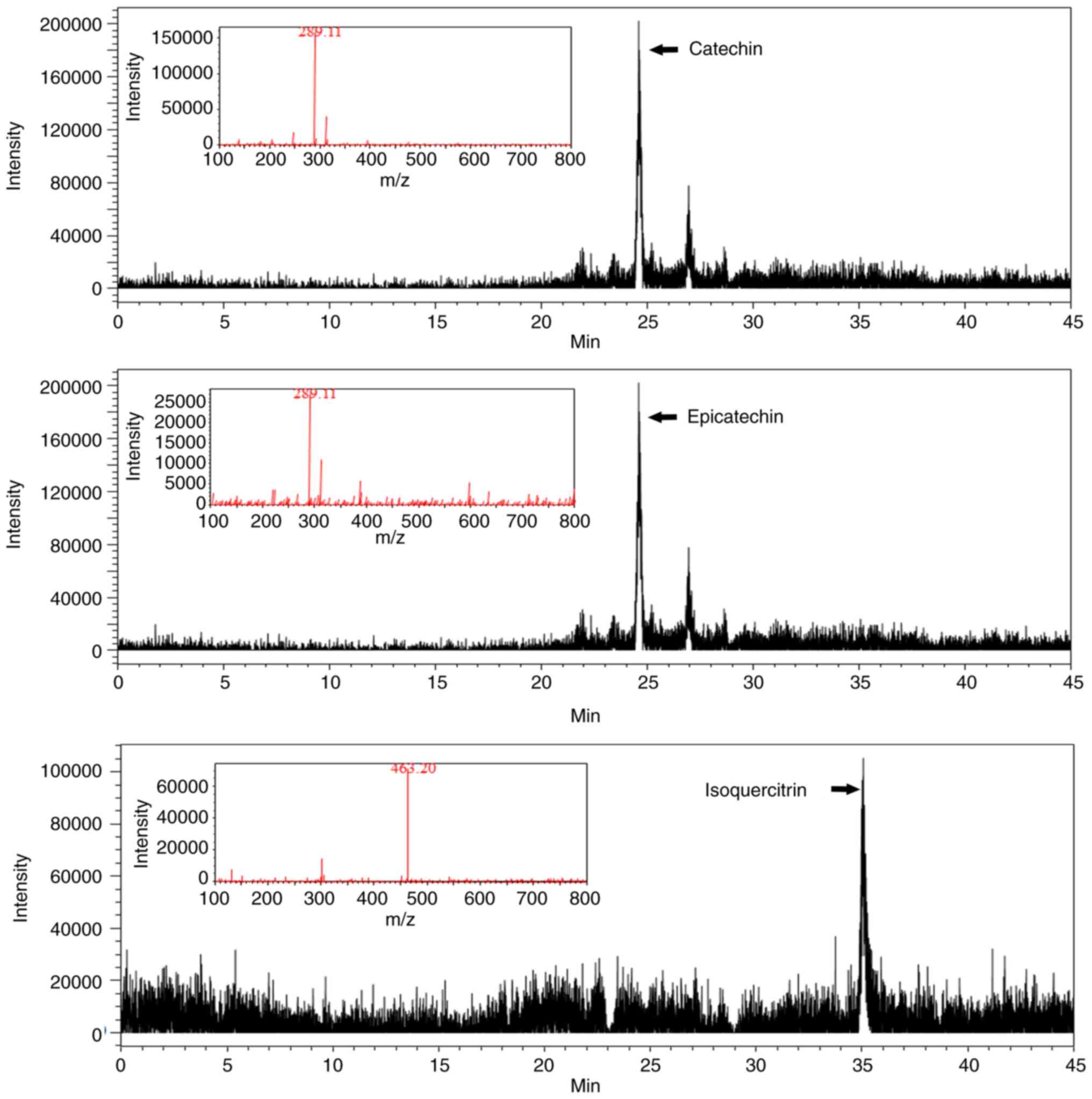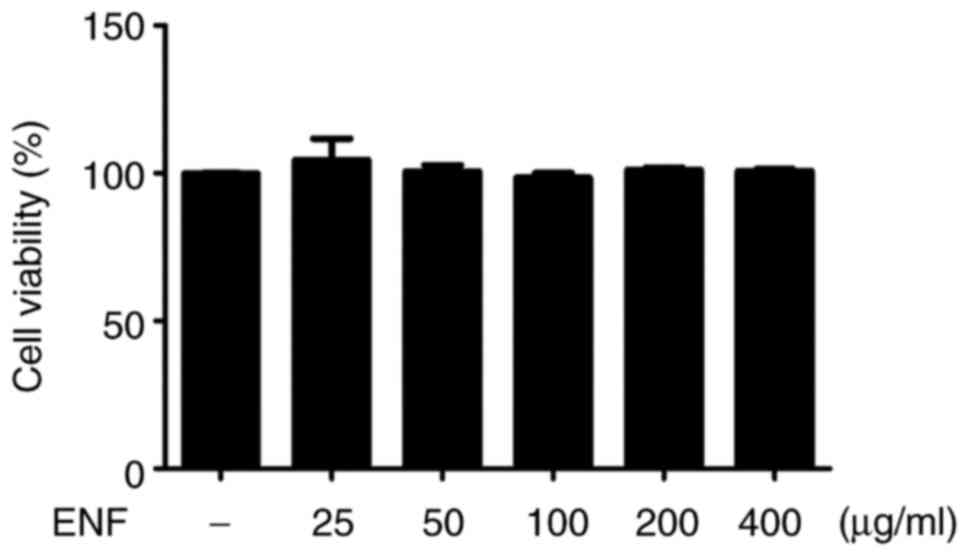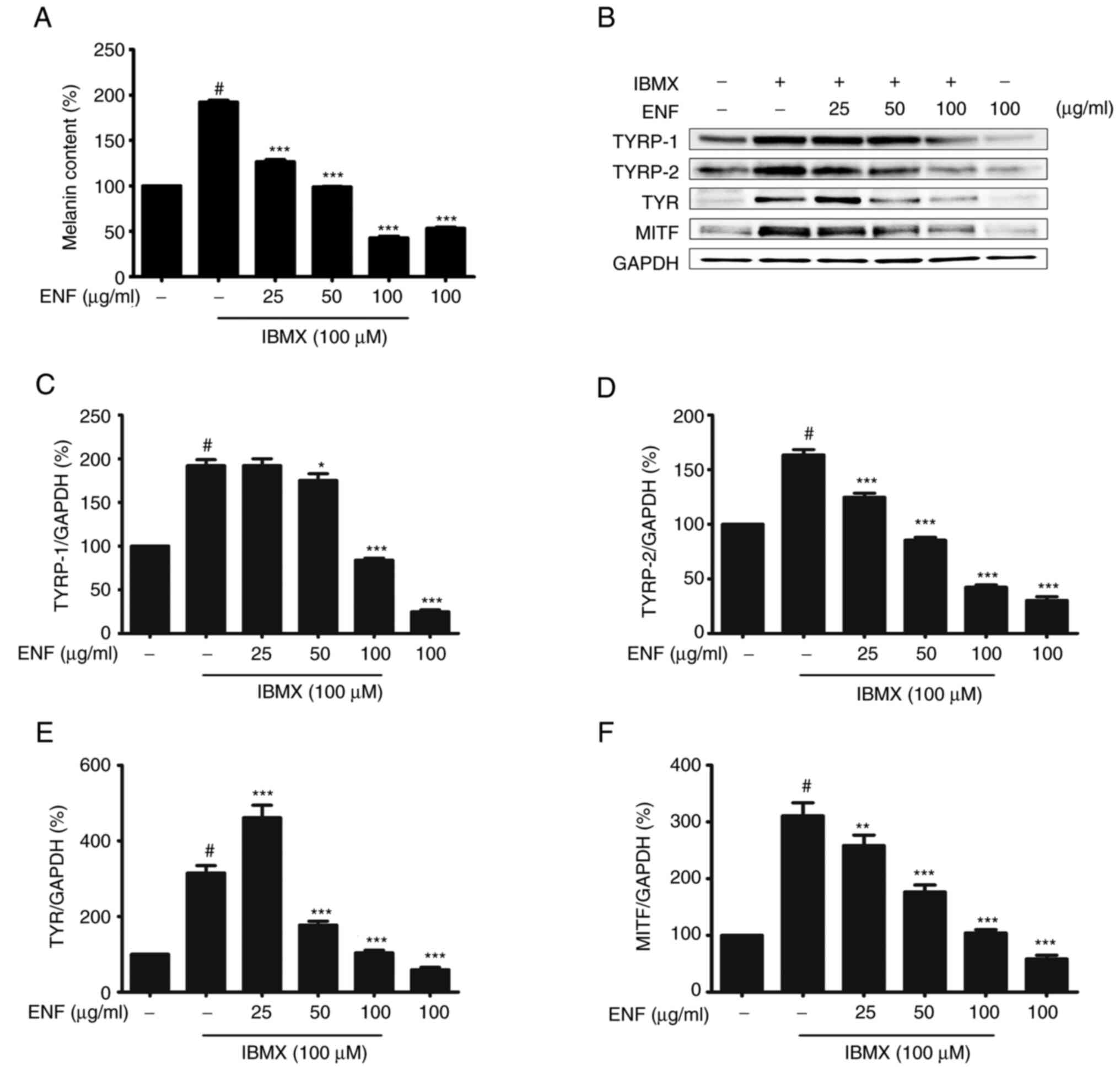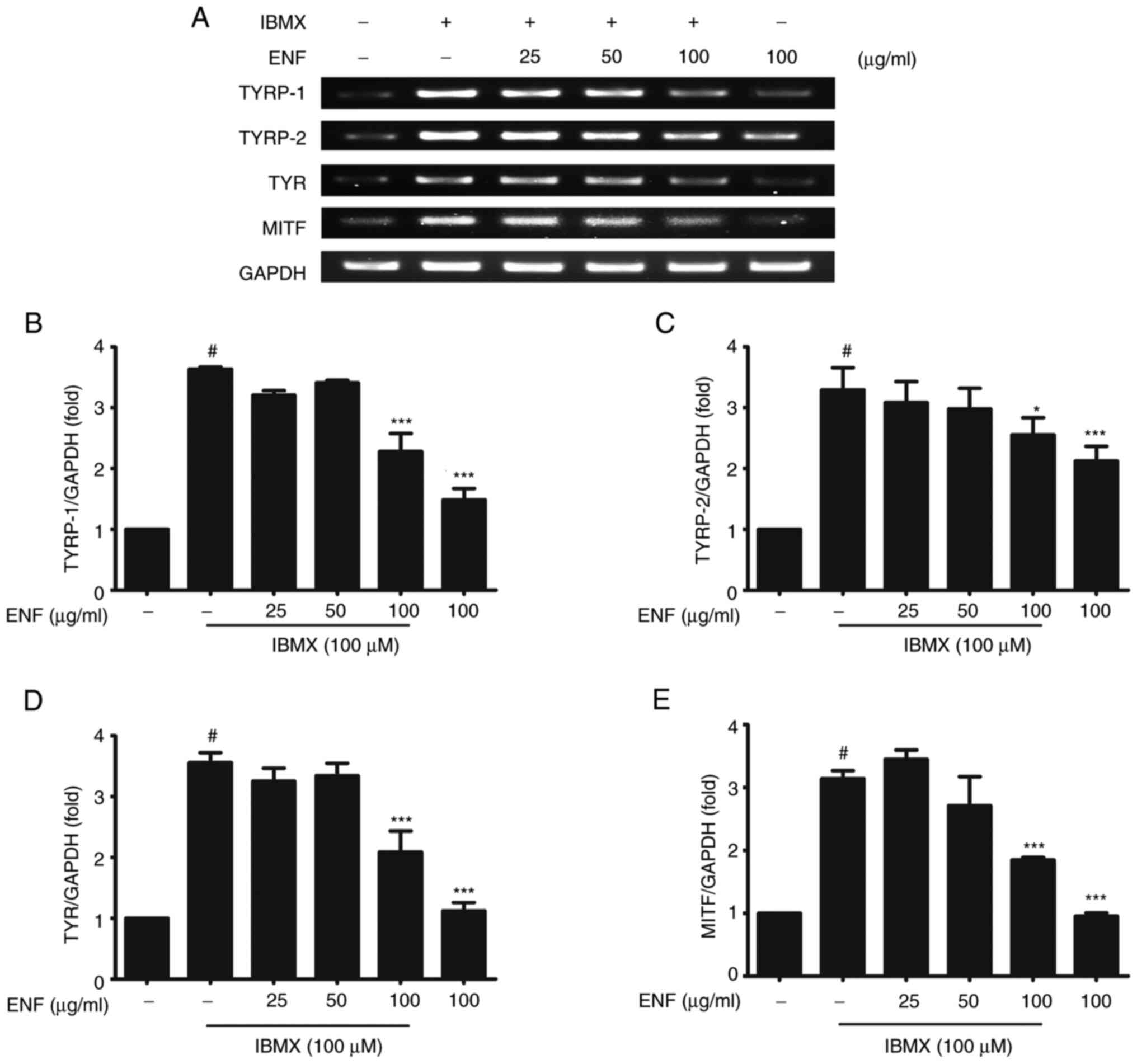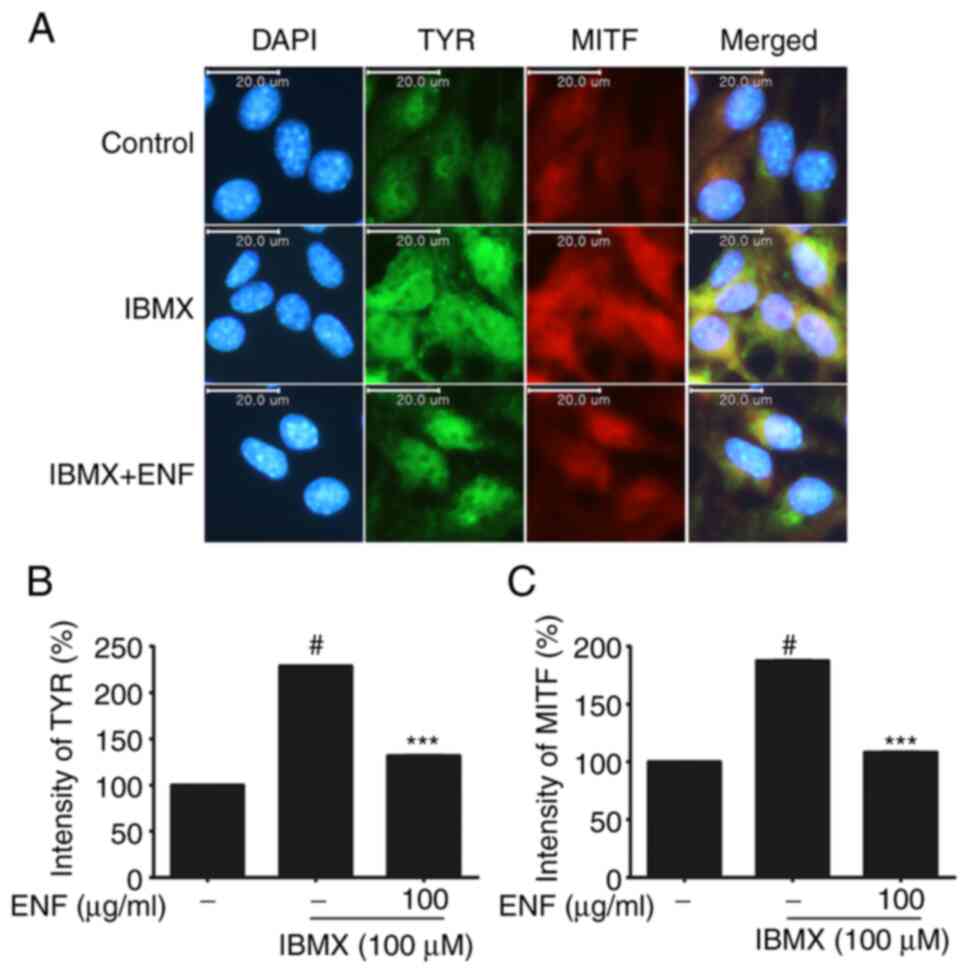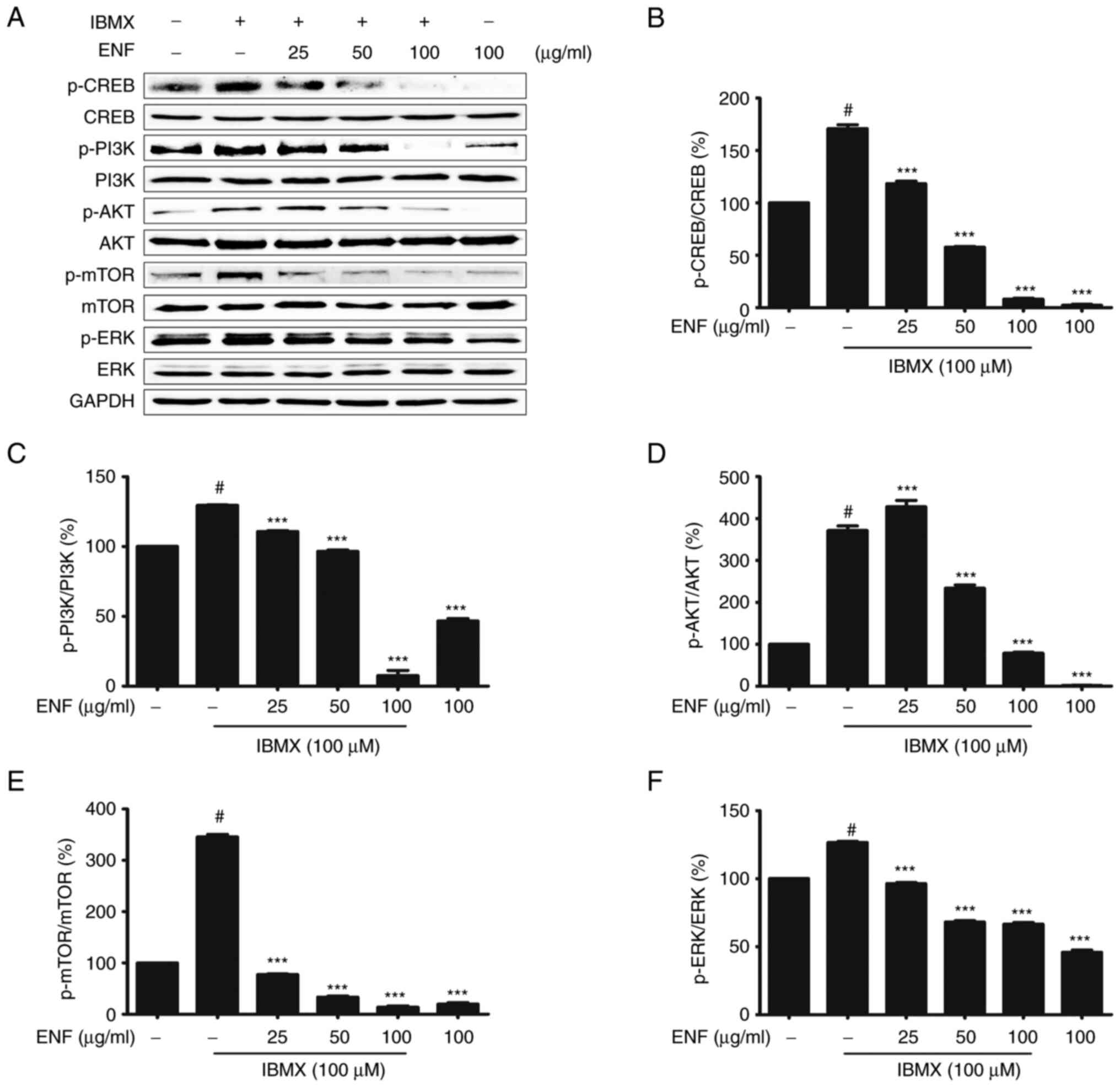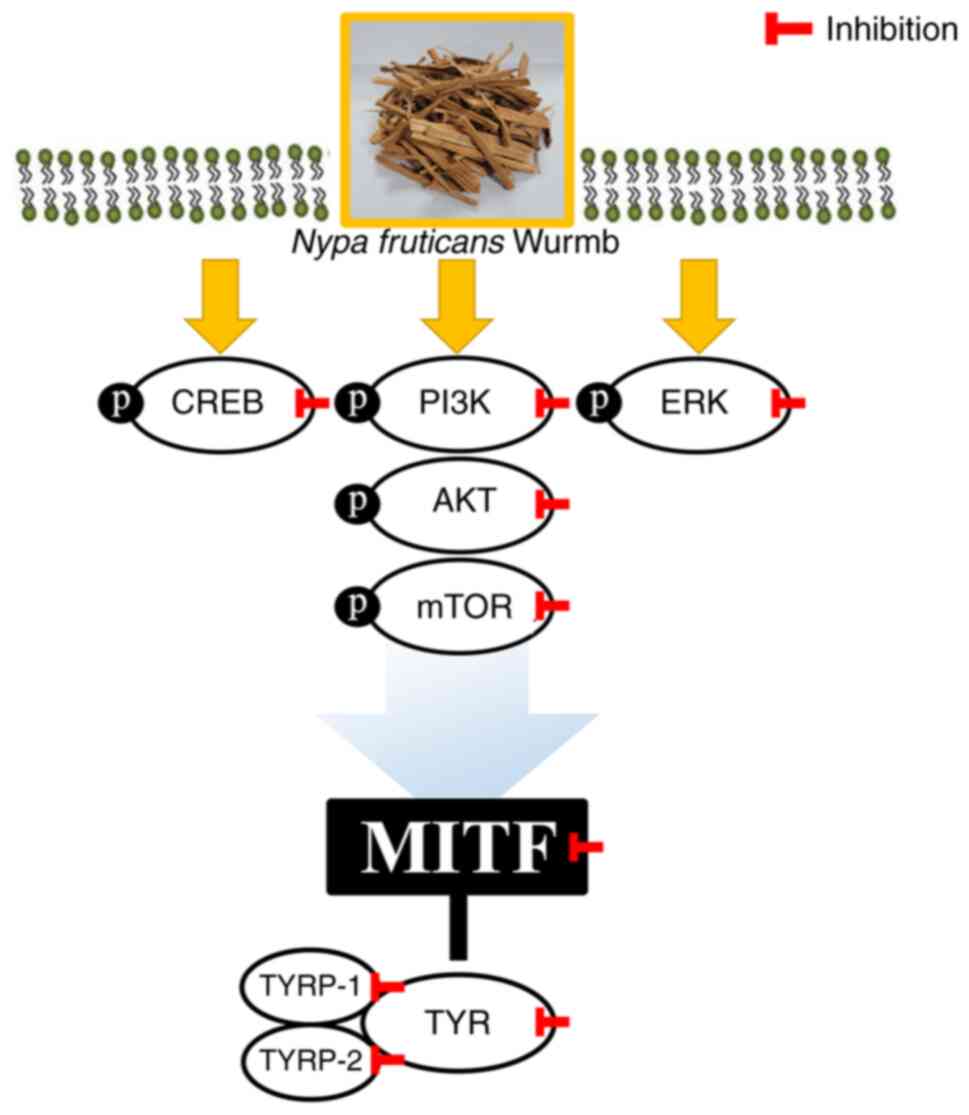|
1
|
Gilchrest BA and Eller MS: DNA photodamage
stimulates melanogenesis and other photoprotective responses. J
Investig Dermatol Symp Proc. 4:35–40. 1999.PubMed/NCBI View Article : Google Scholar
|
|
2
|
Swalwell H, Latimer J, Haywood RM and
Birch-Machin MA: Investigating the role of melanin in UVA/UVB-and
hydrogen peroxide-induced cellular and mitochondrial ROS production
and mitochondrial DNA damage in human melanoma cells. Free Radic
Biol Med. 52:626–634. 2012.PubMed/NCBI View Article : Google Scholar
|
|
3
|
Buscà R and Ballotti R: Cyclic AMP a key
messenger in the regulation of skin pigmentation. Pigment Cell
Melanoma Res. 13:60–69. 2000.PubMed/NCBI View Article : Google Scholar
|
|
4
|
Jiang Z, Xu J, Long M, Tu Z, Yang G and He
G: 2,3,5,4'-Tetrahyd-roxystilbene-2-O-β-d-glucoside (THSG) induces
melanogenesis in B16 cells by MAP kinase activation and tyrosinase
upregulation. Life Sci. 85:345–350. 2009.PubMed/NCBI View Article : Google Scholar
|
|
5
|
Ye Y, Chu JH, Wang H, Xu H, Chou GX, Leung
AK, Fong WF and Yu ZL: Involvement of p38 MAPK signaling pathway in
the anti-melanogenic effect of San-bai-tang, a Chinese herbal
formula, in B16 cells. J Ethnopharmacol. 132:533–535.
2010.PubMed/NCBI View Article : Google Scholar
|
|
6
|
Jung E, Lee J, Huh S, Lee J, Kim YS, Kim G
and Park D: Phloridzin-induced melanogenesis is mediated by the
cAMP signaling pathway. Food Chem Toxicol. 47:2436–2440.
2009.PubMed/NCBI View Article : Google Scholar
|
|
7
|
Han HJ, Park SK, Kang JY, Kim JM, Yoo SK
and Heo HJ: Anti-melanogenic effect of ethanolic extract of
Sorghum bicolor on IBMX-induced melanogenesis in B16/F10
melanoma cells. Nutrients. 12(832)2020.PubMed/NCBI View Article : Google Scholar
|
|
8
|
Bertolotto C, Abbe P, Hemesath TJ, Bille
K, Fisher DE, Ortonne JP and Bauotti R: Microphthalmia gene product
as a signal transducer in cAMP-induced differentiation of
melanocytes. J Cell Biol. 142:827–835. 1998.PubMed/NCBI View Article : Google Scholar
|
|
9
|
Park WS, Kwon O, Yoon TJ and Chung JH:
Anti-graying effect of the extract of Pueraria thunbergiana
via upregulation of cAMP/MITF-M signaling pathway. J Dermatol Sci.
75:153–155. 2014.PubMed/NCBI View Article : Google Scholar
|
|
10
|
Kang YG, Choi EJ, Choi Y and Hwang JK:
5,7-Dimethoxyflavone induces melanogenesis in B16F10 melanoma cells
through cAMP-dependent signalling. Exp Dermatol. 20:445–447.
2011.PubMed/NCBI View Article : Google Scholar
|
|
11
|
Jang JY, Lee JH, Kang BW, Chung KT, Choi
YH and Choi BT: Dichloromethane fraction of Cimicifuga
heracleifolia decreases the level of melanin synthesis by
activating the ERK or AKT signaling pathway in B16F10 cells. Exp
Dermatol. 18:232–237. 2009.PubMed/NCBI View Article : Google Scholar
|
|
12
|
Jang JY, Kim HN, Kim YR, Choi WY, Choi YH,
Shin HK and Choi BT: Partially purified components of
Nardostachys chinensis suppress melanin synthesis through
ERK and Akt signaling pathway with cAMP down-regulation in B16F10
cells. J Ethnopharmacol. 137:1207–1214. 2011.PubMed/NCBI View Article : Google Scholar
|
|
13
|
Kim DS, Jeong YM, Park IK, Hahn HG, Lee
HK, Kwon SB, Jeong JH, Yang SJ, Sohn UD and Park KC: A new
2-imino-1,3-thiazoline derivative, KHG22394, inhibits melanin
synthesis in mouse B16 melanoma cells. Biol Pharm Bull. 30:180–183.
2007.PubMed/NCBI View Article : Google Scholar
|
|
14
|
Cho JH, Robinson JP, Arave RA, Burnett WJ,
Kircher DA, Chen G, Davies MA, Grossmann AH, VanBrocklin MW,
McMahon M and Holmen SL: AKT1 activation promotes development of
melanoma metastases. Cell Rep. 13:898–905. 2015.PubMed/NCBI View Article : Google Scholar
|
|
15
|
Mantiquilla JA, Shiao MS, Lu HY, Sridith
K, Sidique SN, Liyanage WK, Chu YL, Shih HC and Chiang YC: Deep
structured populations of geographically isolated nipa (Nypa
fruticans Wurmb.) in the Indo-West Pacific revealed using
microsatellite markers. Frontiers in Plant Science 13, 2022.
|
|
16
|
Prasad N, Yang B, Kong KW, Sun J, Azlan A,
Ismail A and Romi ZB: Phytochemicals and antioxidant capacity from
Nypa fruticans Wurmb. fruit. Evid Based Complementary Altern
Med: Article ID 154606, 9 pages: 2013.
|
|
17
|
Kim D, Park J, Kim J, Han C, Yoon J, Kim
N, Seo J and Lee C: Flavonoids as mushroom tyrosinase inhibitors: A
fluorescence quenching study. J Agric Food Chem. 54:935–941.
2006.PubMed/NCBI View Article : Google Scholar
|
|
18
|
Kubo I and Kinst-Hori I: Flavonols from
saffron flower: Tyrosinase inhibitory activity and inhibition
mechanism. J Agric Food Chem. 47:4121–4125. 1999.PubMed/NCBI View Article : Google Scholar
|
|
19
|
Itoh K, Hirata N, Masuda M, Naruto S,
Murata K, Wakabayashi K and Matsuda H: Inhibitory effects of
Citrus hassaku extract and its flavanone glycosides on
melanogenesis. Biol Pharm Bull. 32:410–415. 2009.PubMed/NCBI View Article : Google Scholar
|
|
20
|
Rodboon T, Okada S and Suwannalert P:
Germinated riceberry rice enhanced protocatechuic acid and vanillic
acid to suppress melanogenesis through cellular oxidant-related
tyrosinase activity in B16 cells. Antioxidants.
9(247)2020.PubMed/NCBI View Article : Google Scholar
|
|
21
|
Kang MS, Lee GH, Choi GE, Yoon HG and Hyun
KY: Neuroprotective effect of Nypa fruticans wurmb by
suppressing TRPV1 following sciatic nerve crush injury in a rat.
Nutrients. 12(2618)2020.PubMed/NCBI View Article : Google Scholar
|
|
22
|
Kang MS and Hyun KY: Antinociceptive and
anti-inflammatory effects of Nypa fruticans wurmb by
suppressing TRPV1 in the sciatic neuropathies. Nutrients.
12(135)2020.PubMed/NCBI View Article : Google Scholar
|
|
23
|
Jang TW and Park JH: Anti-inflammatory
effects of Abeliophyllum distichum nakai (Cultivar Okhwang
1) callus through inhibition of PI3K/Akt, NF-κB and MAPK signaling
pathways in lipopolysaccharide-induced macrophages. Processes.
9(1071)2021.
|
|
24
|
Son KH, Baek JK, Park SB, Kin HN, Park GH,
Son HJ, Eo HJ, Song JH, Jeong HJ and Jeong JB: Enhancement of
melanin synthesis by the branch extracts of Vaccinium
oldhamii through activating tyrosinase activity in B16F10
melanoma cells. Korean J Plant Res. 31:547–553. 2018.
|
|
25
|
Jin KS, Oh YN, Hyun SK, Kwon HJ and Kim
BW: Betulinic acid isolated from Vitis amurensis root
inhibits 3-isobutyl-1-methylxanthine induced melanogenesis via the
regulation of MEK/ERK and PI3K/Akt pathways in B16F10 cells. Food
Chem Toxicol. 68:38–43. 2014.PubMed/NCBI View Article : Google Scholar
|
|
26
|
Xie X, White EP and Mehnert JM: Coordinate
autophagy and mTOR pathway inhibition enhances cell death in
melanoma. PLoS One. 8(e55096)2013.PubMed/NCBI View Article : Google Scholar
|
|
27
|
Werzowa J, Koehrer S, Strommer S, Cejka D,
Fuereder T, Zebedin E and Wacheck V: Vertical inhibition of the
mTORC1/mTORC2/PI3K pathway shows synergistic effects against
melanoma in vitro and in vivo. J Invest Dermatol. 131:495–503.
2011.PubMed/NCBI View Article : Google Scholar
|
|
28
|
Karbowniczek M, Spittle CS, Morrison T, Wu
H and Henske EP: mTOR is activated in the majority of malignant
melanomas. J Invest Dermatol. 128:980–987. 2008.PubMed/NCBI View Article : Google Scholar
|
|
29
|
Meier F, Schittek B, Busch S, Garbe C,
Smalley K, Stayamoorthy K, Li G and Herdyn M: The RAS/RAF/MEK/ERK
and PI3K/AKT signaling pathways present molecular targets for the
effective treatment of advanced melanoma. Front Biosci.
10:2986–3001. 2005.PubMed/NCBI View
Article : Google Scholar
|
|
30
|
Costin GE and Hearing VJ: Human skin
pigmentation: Melanocytes modulate skin color in response to
stress. FASEB J. 21:976–994. 2007.PubMed/NCBI View Article : Google Scholar
|
|
31
|
D'Mello SA, Finlay GJ, Baguley BC and
Askarian-Amiri ME: Signaling pathways in melanogenesis. Int J Mol
Sci. 17(1144)2016.PubMed/NCBI View Article : Google Scholar
|
|
32
|
Boissy RE, Visscher M and DeLong MA:
DeoxyArbutin: A novel reversible tyrosinase inhibitor with
effective in vivo skin lightening potency. Exp Dermatol.
14:601–608. 2005.PubMed/NCBI View Article : Google Scholar
|
|
33
|
Bloom van Staden A, Oosthuizen CB and Lall
N: The effect of Aspalathus linearis (Burm. f.) R. Dahlgren
and its compounds on tyrosinase and melanogenesis. Sci Rep.
11(7020)2021.PubMed/NCBI View Article : Google Scholar
|
|
34
|
Zhang X, Li J, Li Y, Liu Z, Lin Y and
Huang JA: Anti-melanogenic effects of epigallocatechin-3-gallate
(EGCG), epicatechin-3-gallate (ECG) and gallocatechin-3-gallate
(GCG) via down-regulation of cAMP/CREB/MITF signaling pathway in
B16F10 melanoma cells. Fitoterapia. 145(104634)2020.PubMed/NCBI View Article : Google Scholar
|
|
35
|
Ramli S and Ruangrungsi N: Tyrosinase
inhibition, antioxidant activity and total phenolic content of
selected mimosaceae pericarps ethanolic extracts. Int J Pharm.
4:47–57. 2021.
|
|
36
|
Sato K and Toriyama M: Depigmenting effect
of catechins. Molecules. 14:4425–4432. 2009.PubMed/NCBI View Article : Google Scholar
|
|
37
|
Chen Z, Liang J, Zhang C and Rodrigues CJ
Jr: Epicatechin and catechin may prevent coffee berry disease by
inhibition of appressorial melanization of Colletotrichum
kahawae. Biotechnol Lett. 28:1637–1640. 2006.PubMed/NCBI View Article : Google Scholar
|
|
38
|
Ohguchi K, Nakajima C, Oyama M, Iinuma M,
Itoh T, Akao Y, Nozawa Y and Ito M: Inhibitory effects of flavonoid
glycosides isolated from the peel of Japanese persimmon
(Diospyros kaki ‘Fuyu’) on melanin biosynthesis. Biol Pharm
Bull. 33:122–124. 2010.PubMed/NCBI View Article : Google Scholar
|
|
39
|
Balogun TA, Ipinloju N, Abdullateef OT,
Moses SI, Omoboyowa DA, James AC, Saibu OA, Akinyemi WF and Oni EA:
Computational evaluation of bioactive compounds from Colocasia
affinis schott as a novel EGFR inhibitor for cancer treatment.
Cancer Inform. 20(11769351211049244)2021.PubMed/NCBI View Article : Google Scholar
|
|
40
|
Wang W, Mao S, Yu H, Wu H, Shan X, Zhang
X, Cui G and Liu X: Pinellia pedatisecta lectin exerts a
proinflammatory activity correlated with ROS-MAPKs/NF-κB pathways
and the NLRP3 inflammasome in RAW264.7 cells accompanied by cell
pyroptosis. Int Immunopharmacol. 66:1–12. 2019.PubMed/NCBI View Article : Google Scholar
|
|
41
|
An JH, Won HJ, Seo SK, Kim DY, Ku CS, Oh
SK and Ryu HW: Utilization of [6]-gingerol as an origin
discriminant marker influencing melanin inhibitory activity
relative to its content in Pinellia ternata. J Appl Biol Chem.
59:323–330. 2016.
|
|
42
|
Byun EB, Song HY, Mushtaq S, Kim HM, Kang
JA, Yang MS, Sung NY, Jang BS and Byung EH: Gamma-irradiated
luteolin inhibits 3-isobutyl-1-methylxanthine-induced melanogenesis
through the regulation of CREB/MITF, PI3K/Akt and ERK pathways in
B16BL6 melanoma cells. J Med Food. 20:812–819. 2017.PubMed/NCBI View Article : Google Scholar
|
|
43
|
Hsiao JJ and Fisher DE: The roles of
microphthalmia-associated transcription factor and pigmentation in
melanoma. Arch Biochem Biophys. 563:28–34. 2014.PubMed/NCBI View Article : Google Scholar
|
|
44
|
Du J, Widlund HR, Horstmann MA, Ramaswamy
S, Ross K, Huber WE, Nishimura EK, Golub TR and Fisher DE: Critical
role of CDK2 for melanoma growth linked to its melanocyte-specific
transcriptional regulation by MITF. Cancer Cell Int. 6:565–576.
2004.PubMed/NCBI View Article : Google Scholar
|
|
45
|
Buscà R, Berra E, Gaggioli C, Khaled M,
Bille K, Marchetti B, Thyss R, Fitsialos G, Larribère L,
Bertolotto C, et al: Hypoxia-inducible factor 1α is a new target of
microphthalmia-associated transcription factor (MITF) in melanoma
cells. J Cell Biol. 170:49–59. 2005.PubMed/NCBI View Article : Google Scholar
|
|
46
|
McGill GG, Haq R, Nishimura EK and Fisher
DE: c-Met expression is regulated by Mitf in the melanocyte
lineage. J Biol Chem. 281:10365–10373. 2006.PubMed/NCBI View Article : Google Scholar
|















